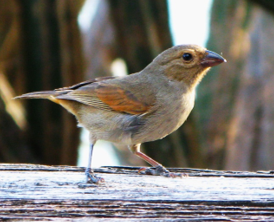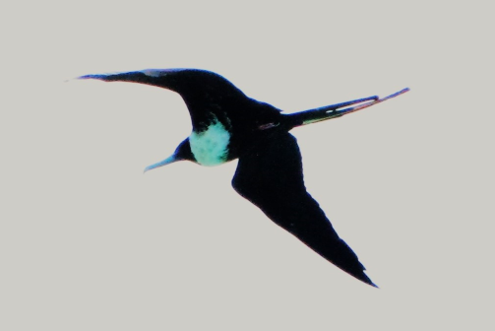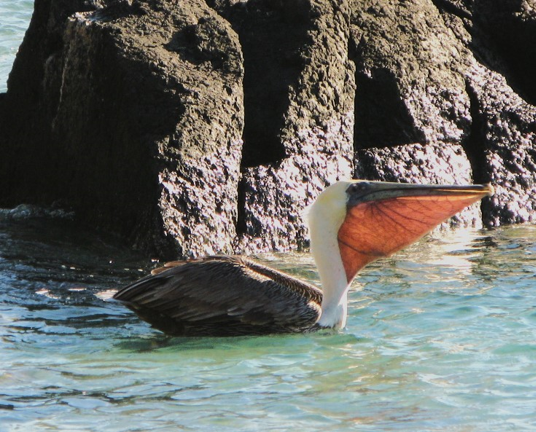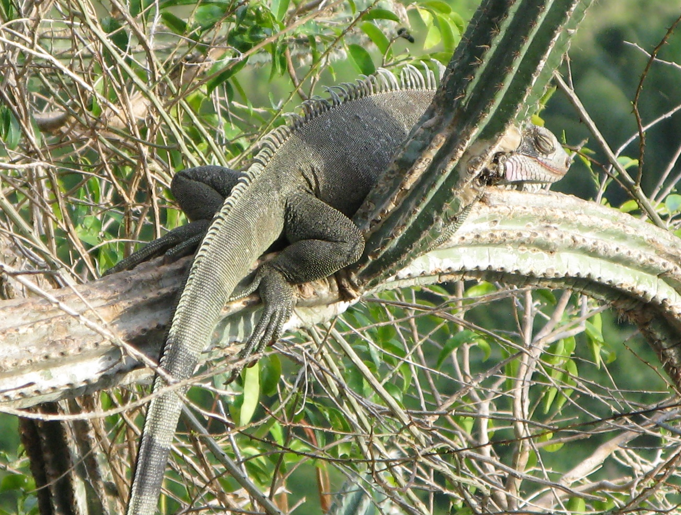Phenological Phacts and Photos w/ Carl Martland / January 2024
A Virtual Caribbean Vacation
Phenology – “a branch of science concerned with the relationship between climate and periodic biological phenomena (as the migration of birds or the flowering and fruiting of plants).”
A Winter Vacation
As winter drags on, week after week, many in the North Country begin to think about a vacation, somewhere where it is warm, where there are beaches, and life proceeds at a slower pace. Well, to be honest, it is hard to proceed at a slower pace than my winter life in Sugar Hill, where an hour or so cutting firewood is followed by twice as much time reading, sipping hot tea in the warmth of the wood stove, eating leftovers, and enjoying Father Brown or one of our other favorite streaming series.
Still, however much I claim to love the warmth by the wood stove, I know that people are sitting on the beach in the Virgin Islands, listening to the waves, and watching sea birds flying high overhead. That is why this month I have prepared a virtual birdwatching vacation for you.
The best sites were located close to the 50-foot bluff that rose nearly straight up from the Bay.
Birds by the Tent-Cottage
Each site had a tent-cottage that covered three quarters of a 16’ x 16’ platform, leaving one corner open where we could take a shower, enjoy a cold drink, watch the iguanas in the cacti, and chat with the fearless little banaquits that looked for sugar that we sprinkled along the railing.
April 10, 2010. A banaquit looks for sugar amid the cracks on the railing of our tent-cottage.
Pearly eyed thrashers and mourning doves would walk along the top of our tent, waking us up in the morning and amusing us as they perched on the rails of our porch during the day. These thrashers stay in the Carribean throughout the year, while the doves, like us, only come for the winter. These birds would join the banaquits and Bahamian bullfinches on the deck railings.
1 Photos and text by Carl D. Martland, founding member of ACT, long-time resident of Sugar Hill, and author of Sugar Hill Days: What’s Happening in the Fields, Wetlands, and Forests of a Small New Hampshire Town on the Western Edge of the White Mountain. Quotations from his book and his journals indicate the dates of and the situations depicted in the photos.
The well-named “Pearly-Eyed Thrasher”is always on the lookout for food.
Female Bahamian bullfinch on the railing of our tent cottage. Notice the cacti in the background.
Magnificent Birds High Overhead
One of the most interesting birds along the coast is the magnificent frigatebird (fregata magnificens) which we frequently watched circling high above Maho Bay, sometimes flying low over the water looking for fish close to the shore. My National Geographic Field Guide shows this bird’s North American range as the warm waters of the Atlantic, the Caribbean, and the Gulf of Mexico, not including any of the mainland or the islands. As their name suggests, frigatebirds are most often seen from the deck of a ship, whether by 18th century Spanish sailors hoping to bring silver back to Spain, English pirates hoping to wreck the Spaniards’ plans, or 21st century tourists enjoying a week-long cruise from Florida to the islands. We, not having access to the deck of a frigate or a cruise ship, had to be content watching these birds from the deck of our tent cottage.
This bird is nearly twice the size of a seagull, and you notice its bright white chest, its long, forked tail and its impressive wingspan as it soars high over the Bay. It certainly is a “magnificent” bird, even if you don’t know about the male’s red little throat patch that is barely visible to the naked eye. During mating season, this nondescript throat patch balloons to a brilliant red chest display that proves to be irresistible to the females of the species.
I only learned about this bird’s range and mating behavior when doing some research for this essay, so I didn’t realize why it was called “frigatebird” and underestimated its “magnificence” as well as its size. It is 40 inches long and has a wingspan of 90 inches. By comparison, the turkey vulture, a much bulkier bird that we commonly see soaring over the hills and fields of the North Country, is only 27 inches long with a wingspan of 69 inches. In fact, the magnificent frigatebird has the largest wingspan relative to its weight of any bird. (Long-time Celtics fans will remember Kevin McHale as a human being with a similarly impressive ratio of “wingspan” to weight.)
Big Birds by the Shore
To get from our tent-cottage to the closest beach, we had to walk a quarter mile or so along the boardwalk, then down about fifty steps to Little Maho Bay, a wonderful beach about two hundred yards long where you could rent a kayak or a paddleboard or buy a snack. We usually continued past this beach, scrambling over a couple of rocky outcroppings, to reach the much longer, wilder beach along Francis Bay. Along the way we would nearly always get close-up views of a couple of brown pelicans. Some would just sit at the shoreline, letting the little wavelets trickle over their feet; others would soar high above the bay; and usually one or two would be flying close to the water, looking for lunch, before suddenly diving down to catch an unsuspecting fish. One day, a pelican was hunting right next to the outcropping that we had to cross on our way to Francis Bay, and I managed to capture the instant when it struck the water with the tip of its beak.
We all know the key fact about pelican anatomy as described by that famous naturalist, Ogden Nash:
A wonderful bird is the pelican.
Its beak can hold more than its belly can.
Very true, and as we walked along the beaches, we would often see a pelican catch a fish, open its beak slightly to allow any water to drain out, then raise its head straight up and gulp down its lunch. One day, when the sun was at the right angle, I took a photo showing how amazingly far the beak could stretch. This bird’s beautiful white head and neck indicate that this was a mature male.
April 17, 2011. A mature pelican has just caught a small fish, which it is holding in the tip of its beak.
The pelicans were certainly a major attraction by the beach, but they weren’t the only large avian visitors. Egrets and herons would also drop in and take up a position along the shoreline waiting for whatever snacks might be brought in by the waves. Great blue heron spend their summers as far north as southern Canada, and they only make it to the Virgin Island in the middle of winter. As the great blue heron can commonly be seen in the North Country, we were more excited to see the great egret and the little blue heron that only migrate as far north as the New Hampshire coast. Although one of these is called “great” and the other is called “little,” they are both nearly as large as the great blue heron. They certainly are very large compared to other egrets and smaller herons that spend their winters in the Caribbean islands.
Great Egret
Francis Bay, April 20, 2013
Little Blue Heron
Francis Bay, April 4, 2009
Birds Feeding in the Lagoon
For me, one of the best features of Maho Bay was the shallow brackish lagoon that was a couple of hundred yards behind the mangroves and palm trees that provided shade next to the beach. A trail led through a tropical forest to a boardwalk parallel to the edge of the lagoon, and there were several locations where a side-boardwalk led right to the edge of the lagoon. When the lagoon was low, thousands of tiny crabs could be seen scurrying in and around the little holes where they lived in the mud flat. These proved to be a great attraction for migratory shore birds.
April 10, 2012. Thousands of inch-long crabs covered the mud flat at the edge of the lagoon behind Francis Bay. Shorebirds feeding on them included lesser yellowlegs (below right) and sandpipers (below left).
Various ducks, egrets, and heron would look for fish in the shallow water of the lagoon, and songbirds flitted about the surrounding woods. The photo below shows a typical view across the greenish water of the lagoon toward some piles of weathered driftwood and the reeds lining the far side of the lagoon. This photo, taken in 2012, included what I first thought was just another pair of drab ducks. Back then, perhaps under the influence of my granddaughter, I apparently was happy to consider this a photo of “lagoon with ducks.” Karoline began her study of birds as a toddler, classifying them into two categories: “duck” and “not a duck.” Today, however, when I zoomed in with my guidebook in hand, I discovered that the two closest birds were white-cheeked pintails, birds of Central and South America that almost never stray as far north as Florida.
April 11, 2012. A pair of white-cheeked pintails feeding in the lagoon behind Francis Bay.
Birds by the Trails
I would almost always see pearly-eyed thrashers, Bahamian bullfinches, doves, and hummingbirds every time I took a walk along the trails and boardwalks near Maho Bay, and always hoped to see something new. One day, as I walked along a trail behind the lagoon, I chanced to see an unknown songbird sitting on a branch over the trail, unwilling to take the effort to fly away as I zoomed in to take its picture (see below). The bold white patches on its tail and its buffy breast turned out to be the classic field marks for mangrove cuckoos, which reside in the Caribbean and central America and only reach the states if blown off course by a storm. Its cousin, the yellow-billed cuckoo, breeds throughout the eastern and central states, and I have heard as well as seen one in Sugar Hill.
April 17, 2011, a mangrove cuckoo has found a fine spot to sit in the middle of a tangle of branches of a mangrove tree near the lagoon behind Francis Bay. This bird clearly is acting properly, as my National Geographic Field Guide says these cuckoos are “found chiefly in mangrove swamps … perching quietly near the center of tree.”
Birds Seen from the Boardwalk
Following a day in the hot sun at the beach, Nancy and I would return to our tent cottage, knowing that some of the deck was now in the shade. We’d get a cold drink and some chips, sit in the shade, and perhaps mull over the life style of an iguana that was sitting in the same position on the same cactus that he had been sitting on when we left for the beach many hours earlier. Someone happening to pass by along the boardwalk, after noticing us sitting motionless and staring at the iguana, could have muttered to themselves, “what a bunch of lazy birds!”















